![]()
|
Felix
& Richard Pratt |
Location and period of operation:
|
Felix & Richard Pratt |
Fenton |
1818 |
1920's |
|
Felix & Richard Pratt |
Fenton |
1818 |
1920's |
| Earthenware
manufacturers at the Fenton Potteries, High Street East, Fenton,
Stoke-on-Trent, England.
The company made earthenware, terra cotta, Rockingham ware. They were also famous for the manufacture of decorated pot lids.
Transfer of the F & R Pratt business:-
|
William Pratt was a master potter at Lane Delph (Fenton) who operated from around 1753 until his death in 1799. The business was continued by his widow with the help of her sons who eventually started up separate businesses in Fenton.
Felix Pratt may have been in business with a William Coomer (business dissolved in Nov 1809)
- Felix Edward Pratt and Richard Pratt formed F & R Pratt and their brother John formed his own company eventually teaming up with William Pratt to form J & W Pratt.
"on the north side Mr. Felix Pratt's House and Manufactory, on the site where Mr. T. Heath made dipped Pottery: and who is mentioned with proper respect for his virtues, is in a subsequent part. The present proprietor is notable for affability and promptitude in alleviating the miseries of the distressed."
from the 'History of the Staffordshire Potteries', published in 1829 by Simeon Shaw.
reference: 'Handbook of British Pottery Manufacturers 1900-2010' by Michael Perry
Selected by the Committee for the Staffordshire Potteries
to exhibit at the Paris Universal Exhibition of 1855
Portrait of Felix Pratt on a china plaque
believed to have been made in 1888courtesy of R K Henrywood - Staffordshire Potters 1781-1900

F and R Pratt & Co,
High Street East
from: 1907
Staffordshire Sentinel
'Business Reference Guide to The Potteries, Newcastle & District'
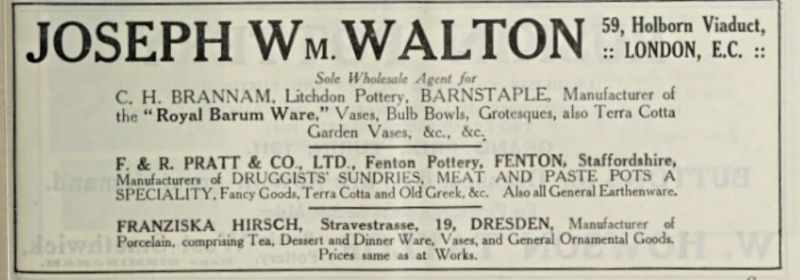
Wholesale Agent's advert -
December 1913
F & R Pratt & Co.
Ltd., Fenton Pottery, Fenton Staffordshire
Manufacturers of Druggists' Sundries, Meat and Paste Pots A Speciality
Fancy Goods, Terra Cotta and old Greek, &c Also all General Earthenware
F & R Pratt Works -
Fenton Pottery, Fenton
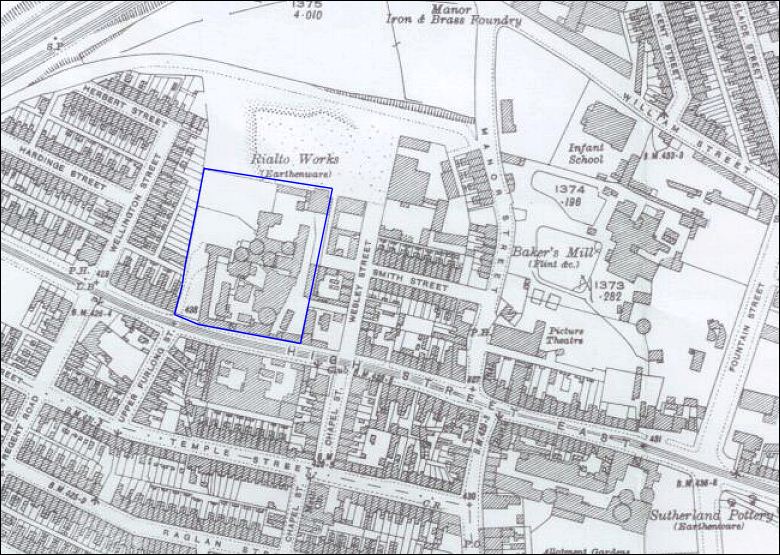
1922 map showing the former
works
of F and R Pratt & Co, High Street East
| F. & R. Pratt was acquired by H. T. Robinson c.1916, and from 1920 it was operating from the Cauldon Place Works in Shelton, Stoke-on-Trent as subsidiary of Robinsonís Cauldon Potteries Ltd. When F. & R. Pratt moved to the Cauldon Place Works The British Art Pottery Co. took over the Fenton Potteries and the works were renamed to the Rialto works. |
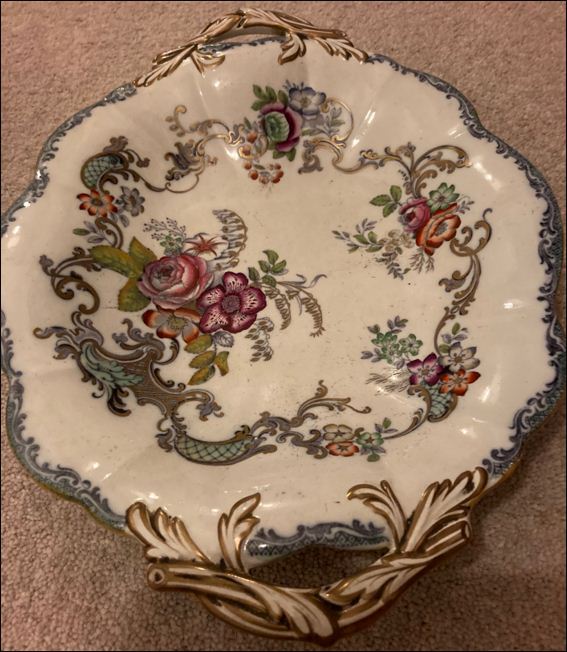
No. 70 is likely to be the pattern number Godden (Encyclopaedia of British
pottery and porcelain Marks) |
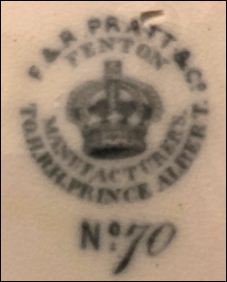 F & R Pratt & Co Fenton Manufacturers to H.R. H. Prince Albert c. 1847-60 |
Etruscan pattern stoneware by F & R Pratt
Prattware Jug - Sailors Fairwell
Prattware Jug
Initials used on ware for identification:
F & R P
F & R P & Co
F & R Pratt & Co
PRATT
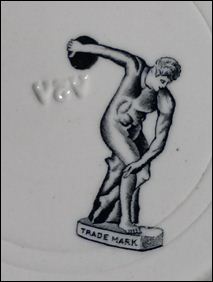
Trade Mark of a nude man with a
discus used by F & R Pratt
with or without the name F & R Pratt
used on ware depicting 'Old
Greek' decoration
generally from 1851-1878
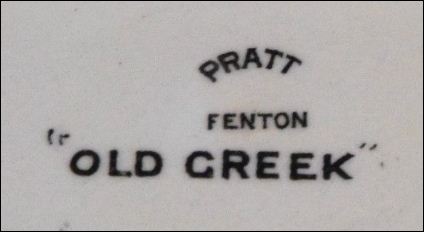
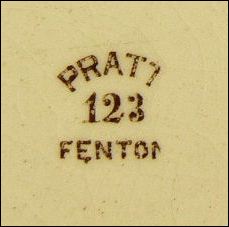
a number of different patterns
and shapes
bore the number 123
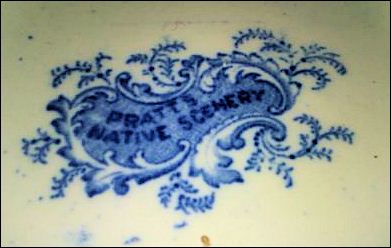
Pratt's Native Scenery
mark used on
blue transfer ware
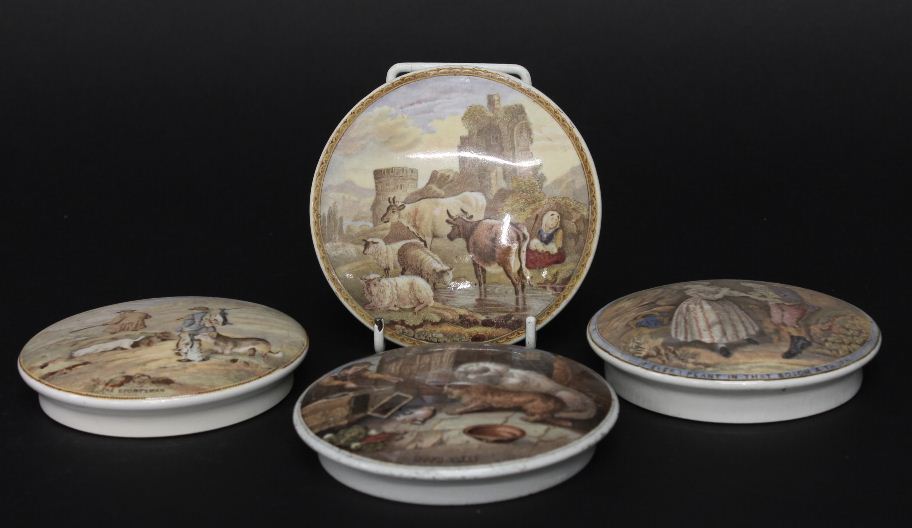
19th Century
Prattware pot lids
The Sportsman,
Both Alike,
No By Heavens Exclaim May I Perish If Ever I Plant In That Bosom A Thorn
the other is decorated with a lady watering cattle
|
Prattware Pot Lids The firm of F. & R. Pratt of Fenton was run by Felix Edward Pratt (1813-1894) who saw the commercial possibilities of producing multicoloured pot lids and bases as containers for products such as bear's grease, gentleman's relish, food-stuffs and cosmetics including rouge. Jesse Austin (1806-1879), who had been an apprentice at Davenport before becoming a self-employed artist and engraver, joined Pratt in about 1843.
Between them they produced a substantial and widely varying selection of what we know today as Staffordshire pot lids and, with the success they enjoyed, they went on to produce Prattware, pottery decorated with the same colour pictures, for a period of some 40 odd years. Austin was a gifted artist and engraver but he had limited imagination and drew inspiration from celebrated paintings, events and other aspects of Victorian life. He painted the designs in watercolour and then etched the copper plates in order to produce the three colour plates and the fourth black key plate.
|

through a number of take-overs Wedgwood
aquired the name and goodwill of both Pratt and Coalport.
Under Wedgwood ownership Coalport continued to produce ware which were decorated
with 'original Pratt prints'
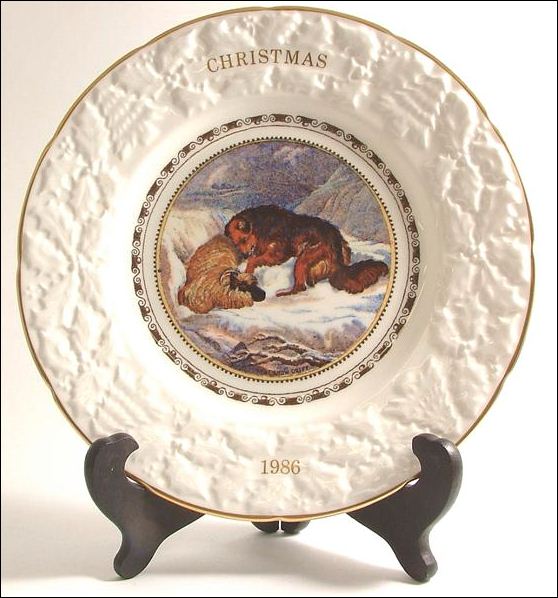
Coalport Christmas 1986
Snow Drift - reproduced from original Pratt prints
Questions, comments, contributions? email: Steve Birks